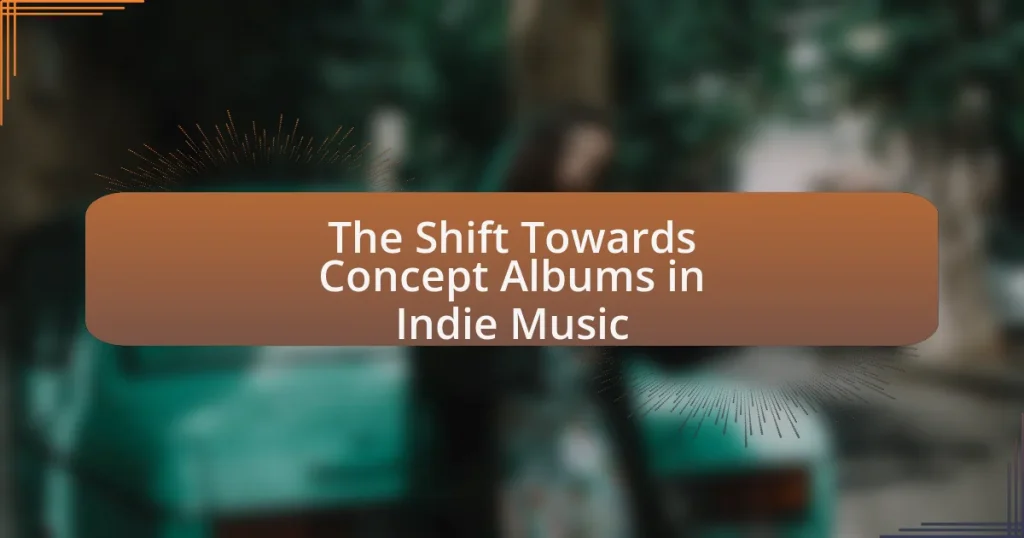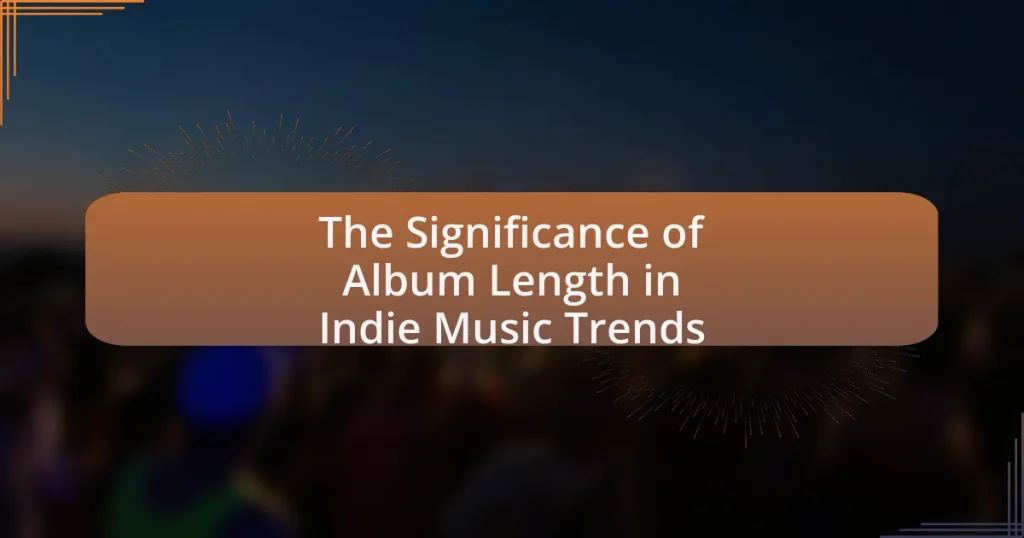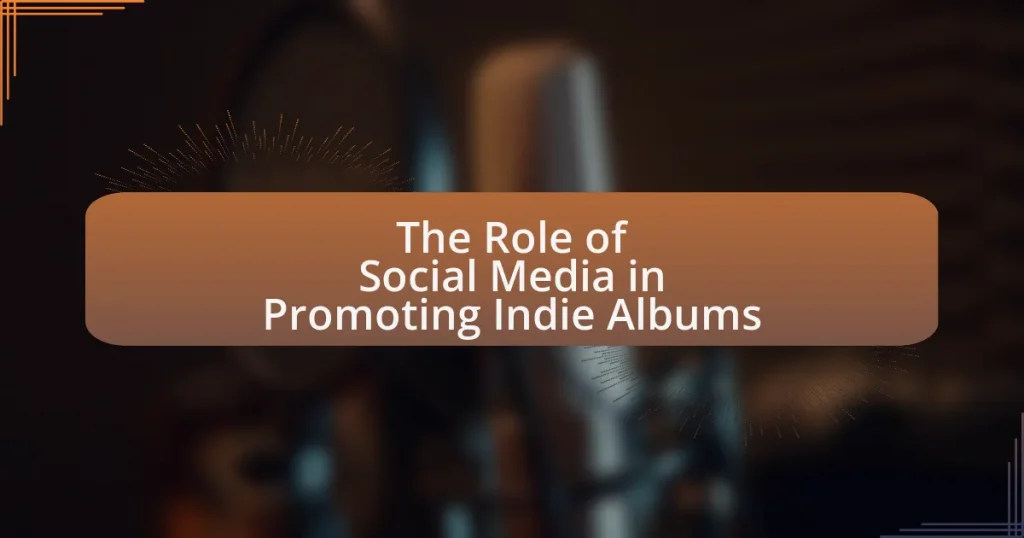The article focuses on how indie artists are leveraging crowdfunding platforms such as Kickstarter and Indiegogo to finance their album releases. It explores various types of crowdfunding models available to artists, including reward-based, donation-based, equity-based, and debt-based options, highlighting their unique features and target audiences. The article also discusses the advantages of crowdfunding, such as creative control and direct fan engagement, while addressing challenges like competition and marketing strategies. Additionally, it provides insights into effective campaign strategies, the importance of compelling narratives and rewards, and the long-term benefits of successful crowdfunding for artists’ careers.
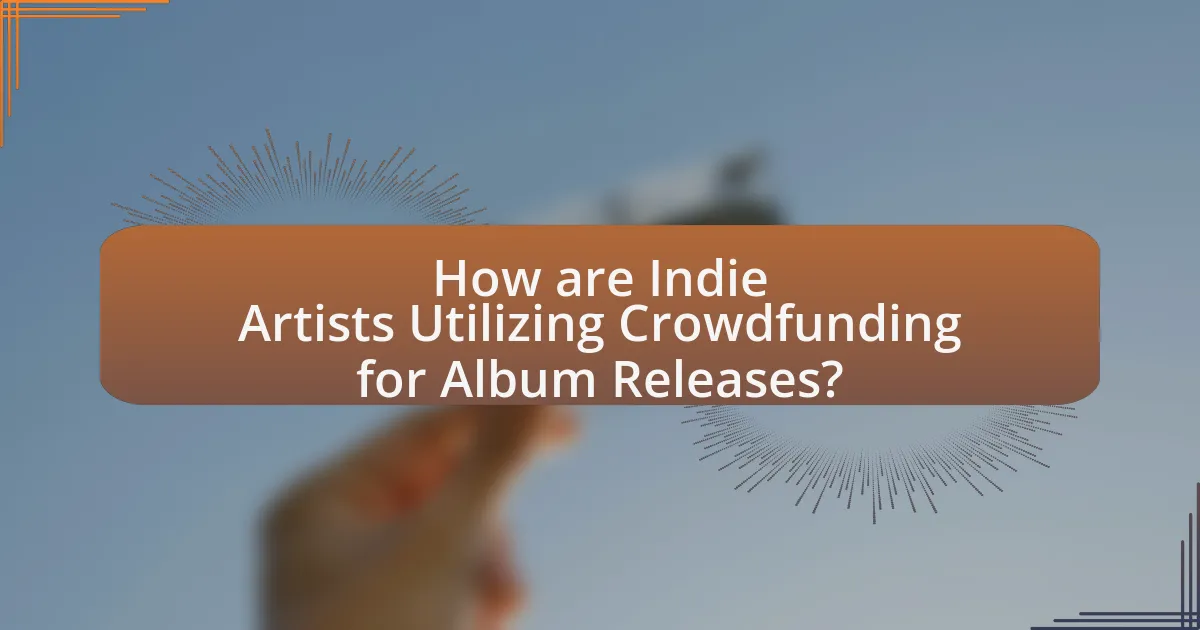
How are Indie Artists Utilizing Crowdfunding for Album Releases?
Indie artists are utilizing crowdfunding for album releases by leveraging platforms like Kickstarter and Indiegogo to secure financial backing directly from their fanbase. This approach allows them to raise funds for recording, production, and marketing costs without relying on traditional record labels. For instance, a study by the University of Southern California found that successful crowdfunding campaigns often engage fans through exclusive rewards, such as pre-orders, merchandise, and behind-the-scenes content, which fosters a sense of community and investment in the artist’s work. Additionally, data from Kickstarter indicates that music projects have raised over $300 million since the platform’s inception, demonstrating the effectiveness of crowdfunding in supporting indie artists’ album releases.
What types of crowdfunding platforms are available for indie artists?
Indie artists have access to several types of crowdfunding platforms, including reward-based, donation-based, equity-based, and debt-based crowdfunding. Reward-based platforms, such as Kickstarter and Indiegogo, allow artists to offer perks in exchange for financial support, making them popular for album releases. Donation-based platforms, like GoFundMe, enable artists to receive funds without offering rewards, focusing instead on community support. Equity-based crowdfunding, available on platforms like SeedInvest, allows artists to offer shares in their projects, while debt-based crowdfunding, found on sites like LendingClub, involves borrowing funds to be repaid with interest. Each type serves different needs and goals for indie artists seeking to finance their music projects.
How do these platforms differ in terms of features and audience?
Crowdfunding platforms for indie artists differ significantly in features and audience. For instance, Kickstarter focuses on project-based funding with an all-or-nothing model, appealing primarily to creative projects and artists seeking substantial financial backing for specific album releases. In contrast, Patreon offers a subscription-based model, allowing artists to build ongoing relationships with fans, which attracts a more dedicated audience interested in continuous support rather than one-time funding. Additionally, Indiegogo provides flexible funding options, enabling artists to keep funds raised even if they do not meet their goal, thus appealing to a broader range of projects and audiences. These differences in funding models and target demographics shape how indie artists engage with their supporters and structure their campaigns.
What are the most popular crowdfunding platforms among indie musicians?
The most popular crowdfunding platforms among indie musicians are Kickstarter, Indiegogo, and Patreon. Kickstarter is widely recognized for its all-or-nothing funding model, which has successfully helped numerous musicians raise funds for album production and tours. Indiegogo offers flexible funding options, allowing artists to keep whatever funds they raise, which appeals to many indie musicians. Patreon, on the other hand, focuses on subscription-based funding, enabling artists to receive ongoing support from fans in exchange for exclusive content. These platforms have collectively facilitated millions of dollars in funding for indie music projects, demonstrating their effectiveness in supporting artists in the music industry.
Why do indie artists choose crowdfunding over traditional funding methods?
Indie artists choose crowdfunding over traditional funding methods primarily for greater creative control and direct engagement with their audience. Crowdfunding platforms allow artists to retain ownership of their work and make decisions without interference from record labels or investors. Additionally, crowdfunding enables artists to gauge interest and build a community around their projects before they are fully realized. According to a 2020 study by the University of Southern California, 64% of indie musicians reported that crowdfunding provided them with a more reliable source of funding compared to traditional methods, which often involve lengthy application processes and stringent requirements. This direct financial support from fans not only helps cover production costs but also fosters a sense of investment and loyalty among supporters.
What advantages does crowdfunding offer to indie artists?
Crowdfunding offers indie artists the advantage of financial support directly from their fanbase, allowing them to fund projects without relying on traditional music industry gatekeepers. This model enables artists to retain creative control and ownership of their work, as they are not bound by record label contracts. Additionally, crowdfunding fosters a sense of community and engagement, as fans feel invested in the artist’s journey and success. According to a study by the University of Southern California, 38% of successful crowdfunding campaigns in the arts sector were for music projects, highlighting the effectiveness of this funding method for indie artists.
How does crowdfunding empower artists in their creative process?
Crowdfunding empowers artists in their creative process by providing them with financial resources directly from their audience, enabling them to create without traditional funding constraints. This model allows artists to gauge interest in their projects before production, ensuring that they invest time and resources into work that has a built-in audience. For instance, platforms like Kickstarter and Indiegogo have facilitated millions in funding for independent music projects, with successful campaigns often raising thousands of dollars, which artists can use for recording, marketing, and distribution. This financial backing not only supports the creation of their work but also fosters a community of supporters who are invested in the artist’s success, enhancing their motivation and creative freedom.
What challenges do indie artists face when using crowdfunding?
Indie artists face several challenges when using crowdfunding, including limited visibility, competition for backers, and the need for effective marketing strategies. Limited visibility arises because many indie artists lack established fan bases, making it difficult to attract attention to their campaigns. Competition for backers is intense, as numerous projects vie for funding on popular platforms like Kickstarter and Indiegogo, leading to potential backer fatigue. Additionally, indie artists must develop and implement effective marketing strategies to promote their campaigns, which often requires skills and resources that they may not possess. According to a study by the University of Southern California, only 36% of music crowdfunding campaigns successfully reach their funding goals, highlighting the difficulties indie artists encounter in this space.
How can artists effectively market their crowdfunding campaigns?
Artists can effectively market their crowdfunding campaigns by leveraging social media platforms, engaging their audience through storytelling, and offering compelling rewards. Social media allows artists to reach a broad audience quickly; for instance, platforms like Instagram and Facebook can be used to share updates, behind-the-scenes content, and personal messages that resonate with potential backers. Engaging storytelling helps create an emotional connection, making supporters feel invested in the project. Additionally, offering unique rewards, such as exclusive merchandise or personalized experiences, incentivizes contributions and enhances the perceived value of the campaign. According to a study by Indiegogo, campaigns that effectively communicate their story and offer attractive rewards see a 50% higher success rate.
What common pitfalls should artists avoid during crowdfunding?
Artists should avoid setting unrealistic funding goals during crowdfunding. Setting goals that are too high can lead to failure in reaching the target, which discourages backers and undermines credibility. Additionally, artists should not neglect to engage with their audience throughout the campaign; lack of communication can result in diminished interest and support. Another pitfall is failing to offer compelling rewards; if the incentives are not attractive, potential backers may choose not to contribute. Lastly, artists should avoid poor marketing strategies; without effective promotion, even the best projects can go unnoticed. These pitfalls are supported by data indicating that campaigns with clear communication and realistic goals have a higher success rate, as shown in studies by Kickstarter, which report that projects with engaged backers are more likely to meet their funding targets.
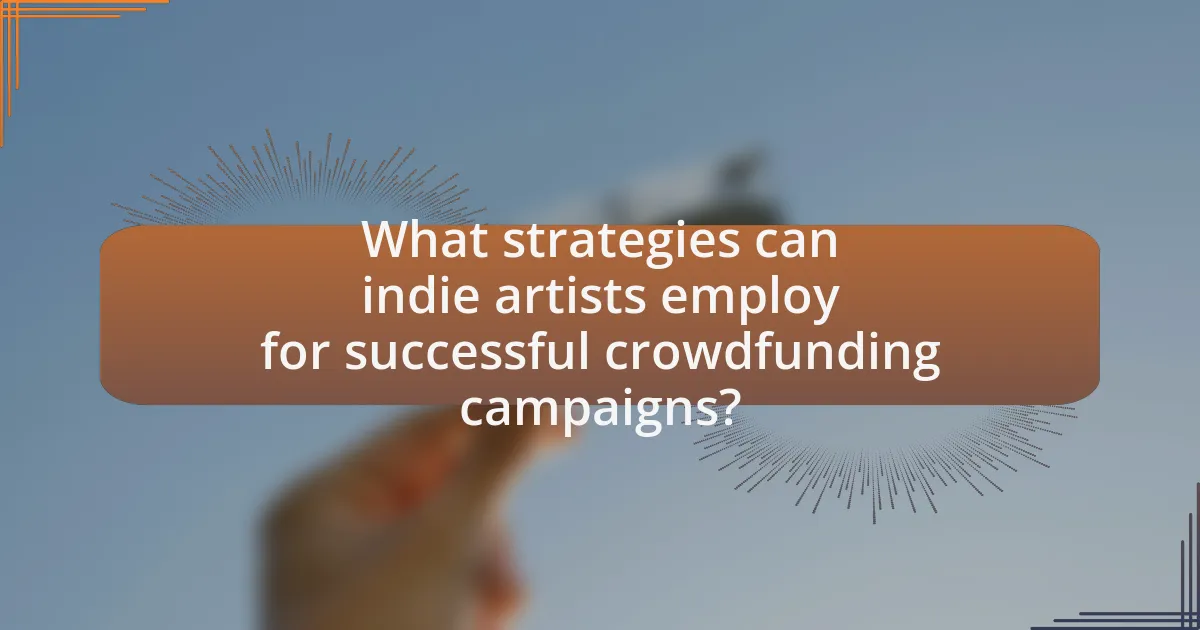
What strategies can indie artists employ for successful crowdfunding campaigns?
Indie artists can employ several strategies for successful crowdfunding campaigns, including building a strong community, offering compelling rewards, and utilizing effective marketing techniques. Building a strong community involves engaging with fans through social media and email newsletters to create a loyal supporter base. Offering compelling rewards, such as exclusive content, merchandise, or personalized experiences, incentivizes backers to contribute. Effective marketing techniques include leveraging social media platforms, creating engaging video content, and utilizing targeted advertising to reach potential supporters. According to a study by the University of Southern California, campaigns that actively engage their audience and provide clear communication about their goals are 50% more likely to reach their funding targets.
How can artists create compelling campaign narratives?
Artists can create compelling campaign narratives by focusing on authenticity, emotional connection, and storytelling. Authenticity allows artists to present their true selves, fostering trust with their audience. Emotional connection can be achieved by sharing personal experiences or challenges related to the album creation process, which resonates with potential supporters. Storytelling is crucial; artists should craft a narrative arc that outlines their journey, the significance of the album, and how contributions will make a tangible impact. For instance, a successful campaign might include anecdotes about the creative process, the inspiration behind the music, and the intended message, which can significantly enhance engagement and support.
What elements should be included in a successful crowdfunding pitch?
A successful crowdfunding pitch should include a clear project description, a compelling story, a defined target audience, a detailed budget, and attractive rewards for backers. The project description outlines the purpose and goals, while the compelling story engages potential backers emotionally, making them feel connected to the project. Identifying a target audience ensures that the pitch reaches the right people who are likely to support the project. A detailed budget provides transparency about how funds will be used, which builds trust with backers. Finally, attractive rewards incentivize contributions by offering backers something valuable in return for their support. These elements are essential as they collectively enhance the pitch’s effectiveness and increase the likelihood of reaching funding goals.
How important are visuals and videos in crowdfunding campaigns?
Visuals and videos are crucial in crowdfunding campaigns, significantly enhancing engagement and funding success. Research indicates that campaigns featuring videos can raise 9% more funds than those without, as visuals effectively convey the project’s story and emotional appeal. Additionally, a study by Indiegogo found that campaigns with images and videos attract 50% more backers, demonstrating that compelling visuals can capture attention and foster trust among potential supporters.
What role do rewards play in crowdfunding for indie albums?
Rewards play a crucial role in crowdfunding for indie albums by incentivizing backers to contribute financially. These rewards, which can range from digital downloads to exclusive merchandise or private concerts, create a tangible value proposition for supporters, motivating them to invest in the project. According to a study by the University of Pennsylvania, campaigns that offer well-structured rewards tend to achieve higher funding success rates, as they engage potential backers by providing them with a sense of ownership and connection to the album. This strategy not only enhances the likelihood of reaching funding goals but also fosters a community around the artist, increasing long-term support and engagement.
What types of rewards are most appealing to backers?
Backers are most appealed by rewards that offer exclusive experiences and tangible items. Exclusive rewards such as behind-the-scenes access, personalized merchandise, and limited edition products create a sense of connection and value for backers. Research indicates that campaigns offering unique experiences, like private concerts or meet-and-greets, tend to attract more funding, as they provide backers with memorable interactions that are not available to the general public. Additionally, tangible rewards like vinyl records or signed albums resonate well, as they serve as physical tokens of support and connection to the artist.
How can artists balance reward costs with campaign goals?
Artists can balance reward costs with campaign goals by strategically selecting rewards that align with their budget and the interests of their supporters. By analyzing the potential costs of various rewards, artists can set tiered pricing that reflects both the value of the rewards and the financial goals of the campaign. For instance, offering digital downloads or exclusive content at lower tiers can attract more backers without significantly increasing costs, while higher tiers can include more expensive rewards like merchandise or personalized experiences, which should be limited to ensure profitability. This approach allows artists to maximize funding while maintaining a sustainable cost structure, ultimately leading to a successful crowdfunding campaign.
How can indie artists leverage social media for crowdfunding success?
Indie artists can leverage social media for crowdfunding success by actively engaging their audience, sharing compelling content, and utilizing targeted advertising. Engaging with followers through regular updates, behind-the-scenes content, and personal stories fosters a sense of community and investment in the artist’s journey. For instance, artists can use platforms like Instagram and Facebook to showcase their creative process, which can lead to increased emotional support and financial backing from fans. Additionally, targeted ads on these platforms can reach potential supporters who align with the artist’s genre and style, enhancing the likelihood of successful crowdfunding campaigns. According to a study by the University of Southern California, artists who actively engage with their audience on social media see a 30% increase in crowdfunding success rates compared to those who do not.
What platforms are most effective for promoting crowdfunding campaigns?
The most effective platforms for promoting crowdfunding campaigns are Kickstarter, Indiegogo, and GoFundMe. Kickstarter is renowned for creative projects, particularly in music, where indie artists can showcase their work and connect with backers. Indiegogo offers flexible funding options, allowing artists to keep funds raised even if they do not meet their goal, which is beneficial for indie musicians. GoFundMe is widely used for personal causes and can be effective for artists seeking support for album releases or tours. According to a 2021 report by Statista, Kickstarter raised over $5 billion since its inception, highlighting its effectiveness in crowdfunding.
How can artists engage their audience before and during the campaign?
Artists can engage their audience before and during the campaign by utilizing social media platforms to share behind-the-scenes content and updates. This approach fosters a sense of community and investment among fans, as they feel included in the creative process. For instance, a study by the University of Southern California found that artists who actively interact with their audience on platforms like Instagram and Twitter see a 30% increase in engagement rates. Additionally, hosting live Q&A sessions or virtual events allows artists to connect directly with their audience, enhancing their emotional investment in the campaign.
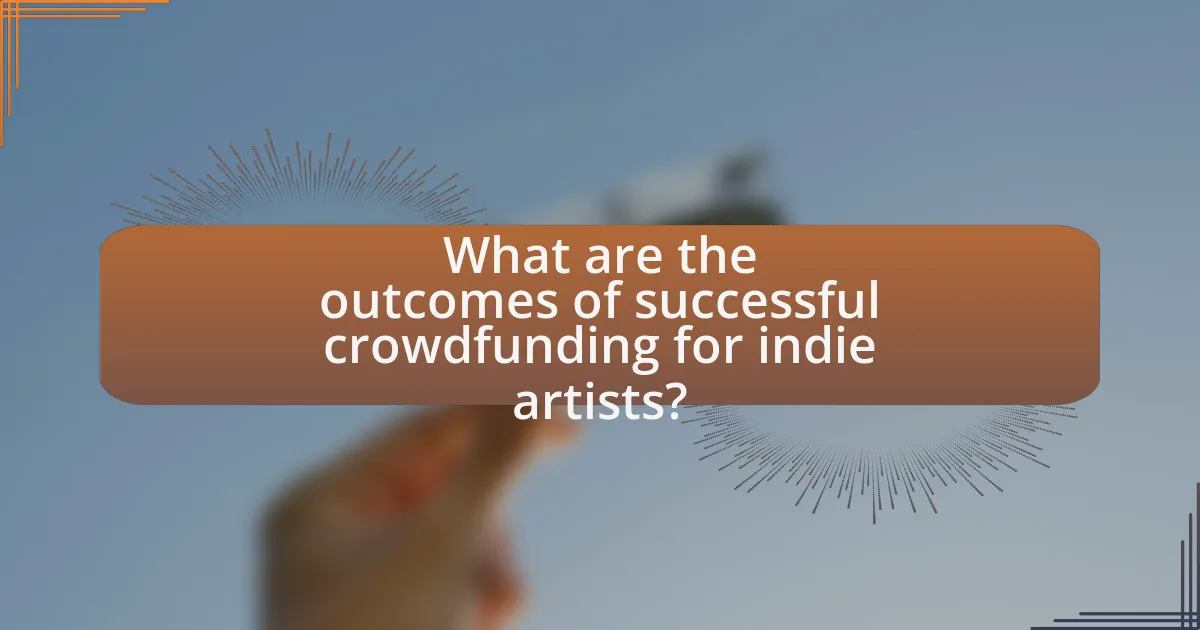
What are the outcomes of successful crowdfunding for indie artists?
Successful crowdfunding for indie artists typically results in financial support, increased visibility, and community engagement. Financially, artists can secure the necessary funds to produce albums, cover production costs, and promote their work, which is crucial given that 60% of musicians report financial challenges in their careers. Increased visibility occurs as campaigns often attract attention from media and potential fans, leading to a broader audience reach. Community engagement is fostered as backers feel invested in the artist’s journey, creating a loyal fan base that can lead to future support and collaboration opportunities. These outcomes collectively enhance the artist’s career trajectory and sustainability in the music industry.
How does crowdfunding impact an artist’s career trajectory?
Crowdfunding significantly impacts an artist’s career trajectory by providing financial support and fostering community engagement. This funding model allows artists to raise capital for projects, such as album production, without relying solely on traditional music industry channels. For instance, a study by the University of Southern California found that artists who successfully use crowdfunding often experience increased visibility and fan loyalty, which can lead to higher sales and concert attendance. Additionally, platforms like Kickstarter and Indiegogo have enabled artists to connect directly with their audience, creating a sense of ownership among backers that can enhance long-term support for the artist’s career.
What are the long-term benefits of a successful crowdfunding campaign?
A successful crowdfunding campaign provides long-term benefits such as increased financial stability, enhanced community engagement, and valuable market validation for indie artists. Financially, artists can secure funds upfront to cover production costs, allowing them to invest in high-quality recordings and marketing efforts. Community engagement fosters a loyal fan base, as backers feel personally connected to the project, often leading to sustained support for future endeavors. Additionally, market validation occurs when a campaign meets or exceeds its funding goal, signaling to the artist and industry that there is demand for their music, which can attract further investment and opportunities. These benefits collectively contribute to the artist’s growth and sustainability in the competitive music industry.
How can crowdfunding lead to further opportunities for indie artists?
Crowdfunding can lead to further opportunities for indie artists by providing them with the necessary financial resources to produce and promote their music. This financial backing allows artists to create high-quality albums, which can enhance their visibility and attract a larger audience. For instance, successful crowdfunding campaigns can generate a loyal fan base that is more likely to support future projects, attend live shows, and purchase merchandise. Additionally, platforms like Kickstarter and Indiegogo have enabled artists to showcase their work to a global audience, increasing their chances of collaboration with other musicians and industry professionals. Statistics show that 64% of crowdfunding backers are motivated by a desire to support artists they believe in, which can lead to long-term relationships and opportunities in the music industry.
What lessons can be learned from successful indie crowdfunding campaigns?
Successful indie crowdfunding campaigns demonstrate the importance of building a strong community and engaging with potential backers. Campaigns that effectively communicate their vision and establish a personal connection with supporters tend to achieve higher funding goals. For instance, the successful campaign for the album “The Last Goodbye” by indie artist Tori Amos raised over $100,000 by leveraging her existing fan base and providing exclusive rewards, showcasing the effectiveness of community engagement. Additionally, clear and compelling storytelling about the project can significantly enhance backer interest, as seen in the campaign for the “Veronica Mars” movie, which raised $5.7 million, illustrating how a well-articulated narrative can resonate with supporters.
What case studies exemplify effective crowdfunding strategies?
Successful case studies of effective crowdfunding strategies include Amanda Palmer’s “Theatre Is Evil” campaign, which raised over $1.2 million on Kickstarter, significantly exceeding its $100,000 goal. This campaign exemplified effective engagement with fans through personalized rewards and transparent communication, leading to a strong community investment in her project. Another notable example is the band The Oatmeal, which raised $1.3 million for a comic book and educational game through Indiegogo, showcasing the power of a dedicated fanbase and a clear, compelling project narrative. These case studies illustrate how indie artists can leverage crowdfunding by fostering community involvement and offering unique incentives.
How can artists apply these lessons to future projects?
Artists can apply lessons from crowdfunding to future projects by leveraging community engagement and transparent communication. By actively involving their audience in the creative process, artists can foster a sense of ownership and loyalty, which has been shown to increase support and funding. For instance, successful campaigns often highlight the importance of setting clear goals and providing regular updates, as seen in the case of the band Amanda Palmer, whose Kickstarter campaign raised over $1.2 million by maintaining open dialogue with backers. This approach not only builds trust but also encourages repeat support for subsequent projects.
What best practices should indie artists follow for crowdfunding?
Indie artists should focus on building a strong community and engaging their audience to successfully crowdfund their projects. Establishing a loyal fan base through social media and live performances creates a foundation for support. Additionally, artists should set clear, achievable funding goals and offer compelling rewards that resonate with their audience, such as exclusive content or experiences. Research indicates that campaigns with well-defined goals and attractive rewards tend to achieve higher funding success rates. For instance, a study by the University of Southern California found that campaigns with specific funding targets raised 20% more than those without. Furthermore, maintaining transparency throughout the campaign by providing regular updates fosters trust and encourages backers to contribute.
How can artists prepare for a crowdfunding campaign effectively?
Artists can prepare for a crowdfunding campaign effectively by developing a clear project plan, establishing a budget, and building a strong community of supporters. A well-defined project plan outlines the goals, timeline, and deliverables, ensuring that potential backers understand what their contributions will support. Establishing a budget helps artists set realistic funding goals and allocate resources efficiently, which is crucial for transparency and trust. Additionally, engaging with a community through social media and email newsletters prior to the campaign can create excitement and anticipation, leading to a higher likelihood of success. Research indicates that campaigns with a pre-existing supporter base tend to raise more funds, as seen in a study by the University of Pennsylvania, which found that projects with prior engagement raised 50% more than those without.
What tips can help ensure a smooth crowdfunding experience?
To ensure a smooth crowdfunding experience, indie artists should create a detailed campaign plan that outlines goals, target audience, and marketing strategies. A well-defined plan helps maintain focus and clarity throughout the campaign. Additionally, artists should engage with their audience early and often, providing updates and responding to inquiries, which fosters community support and trust. Research indicates that campaigns with regular updates are 50% more likely to reach their funding goals. Finally, setting realistic funding targets and offering attractive rewards can motivate backers to contribute, as evidenced by successful campaigns that align rewards with backer interests.

